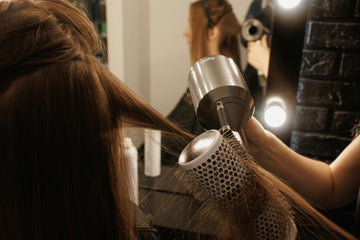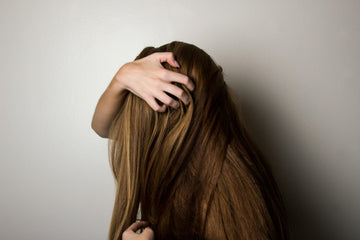We’ve all seen our hair go from fab to drab in an instance—well, you have your hair’s porosity to thank for that.
Are you tired of the endless cycle of trying out different hair care products, only to be left disappointed when they don't deliver the results you're looking for? If so, you're not alone. Many of us have been there, conditioning and moisturizing like no tomorrow, only to find our hair still plagued by dryness and frizz. But fear not—there might be a solution you haven't considered yet—and that’s the wild and wonderful world of understanding your hair's porosity.
Porosity is your hair's ability to retain and absorb moisture—an extremely important factor in determining its overall health and appearance. While genetics are usually to blame for your hair porosity (thanks mum), other factors such as chemical treatments, environmental conditions, and heat styling can also influence it—oh, and those bleaching days of the past? Well, there’s your culprit.
Like your hair type, knowing your hair porosity is also needed for selecting the right products and ingredients to address your hair's unique needs. It's this insider knowledge that empowers you to make informed decisions about your hair care routine, from choosing the best conditioners to determining which styling techniques will give you the best results. Whether you're battling frizz or seeking hydration, understanding your hair porosity is the key to unlocking your hair's full potential.
So, if you're ready to break free from the cycle of trial and error and take control of your hair once and for all—you've come to the right place. Bad hair days no more, let’s take a walk down the hall of hair porosity fame and discover how understanding this fundamental concept can transform your hair game for the better.
What is hair porosity?
Before we dive into why hair porosity is essential, let's first understand and break down what it actually means and what it is. Hair porosity refers to your hair's ability to absorb and retain moisture—and essentially, it determines how well your strands can soak up and hold onto the products you apply, influencing everything from hydration levels to styling results. So if your curls are dropping or your hair takes too long to dry, chances are it’s down to its level of porosity. Hair porosity is typically categorized into three main types—low porosity, medium porosity, and high porosity.
To put it plain and simple, imagine your hair as a sponge—just like a sponge absorbs and holds onto water, your hair absorbs and retains moisture. Now, picture three different sponges—one with tightly packed holes, one with medium-sized holes, and one with large holes. These sponges represent low, medium, and high porosity hair, respectively.
The sponge with tightly packed holes (low porosity hair) struggles to absorb water, while the one with large holes (high porosity hair) quickly soaks up water but struggles to retain it. Finally, the medium porosity sponge strikes a balance between the two, absorbing and holding onto water effectively.
It all comes down to which sponge you are, and understanding your hair's porosity is like knowing which one you’re working with. As the high-maintenance queen it is, when it's given the right hair care routine for its needs, then it will shine the night away (and do as it’s told).
Why is hair porosity important?
Hair porosity affects how your strands interact with products, meaning that using the wrong products can lead to lackluster results or even damage, breakage, and all the things we do not want. For instance, girlies with low porosity hair may struggle to absorb moisture effectively, resulting in product buildup and frizz. On the other hand, those with high porosity hair may find that their strands quickly lose moisture, leading to dryness and breakage and craving those nourishing oils.
Think of it this way—if you have a straw with holes in it, you can easily take in liquid, but you can't retain it. Once you remove the straw from the liquid, it all runs out. Similarly, high-porosity hair quickly absorbs moisture but struggles to retain it, leading to dryness and frizz.
By getting to grips with these simple analogies on your hair's porosity, you are then set up to select the best possible products and haircare techniques to nourish those tresses.
How to test hair porosity
Now that we've covered how important hair porosity is, let’s take a look at how to work out your hair's porosity level accurately. There are several methods you can try at home to assess your hair's porosity, from simple observations to more hands-on tests—and we’ve done all the digging to get them for you.
There is an old-age method involving placing a strand of clean, dry hair in a bowl of water and observing how it behaves—and if the hair sinks quickly, it likely has high porosity, while if it floats, it may have low porosity.
Experiment with different techniques to find the one that works best for you.
Hair porosity test—the float test
There are some simple ways you can test your hair's porosity at home, and all you need are two things—a glass of water (use a clear glass) and a strand of hair (yours, of course).
We recommend that you try this after washing with a clarifying shampoo to remove any product and build-up from your strands, as this will give you the most accurate reading. Start by combing your hair to release strands that are shedding, and then take those stands and drop them into your glass of water.
Hair that is low porosity will float. Hair that is 'normal' porosity will float and then begin to sink slowly. Hair that is high porosity will sink immediately. Determining your hair porosity will inform your product decisions and hair care routine so your hair gets the moisture it needs.
Consideration for curly and wavy hair
Curly girls be aware! While hair porosity is important for all hair types, curly and wavy hair girlies should especially be knowledgeable of their porosity type as curly hair tends to dry out more easily (sigh). Curly hair has a natural tendency for dryness because the natural oils your scalp produces can travel down the strand of straight hair much easier than a curly one. So, even with healthy and normal porous hair, moisture is always essential to keep those curls glossy and shining.
The strand test
Another option for at-home porosity testing is the strand test, which works especially well if you have curly hair (we got you). To perform the strand test, gently stretch a tiny section of curl strands from different areas of your head—front hairline, crown, or temple.
Place the stretched curl between your thumb and finger and slide it up the hair strand from the tip towards your scalp. If your fingers move easily up the strand and it feels dense and hard, you have low porosity hair. If it feels smooth, you have normal porosity hair, and if the strand feels rough, dry, or breaks, you have high porosity hair—sadly.
You don’t have to be a hair salon expert to learn about the ins and outs of your hair, by performing these simple tests at home, you can gain valuable insights into your hair's porosity level—allowing you to tailor your hair care routine to its high maintenance behavior. Whether your hair is low, normal, or high porosity, understanding its unique characteristics is the first step towards achieving healthy, hydrated, and vibrant locks, and it’s all worth the wait.
Caring for different types of porosity
If you’ve got this far, then you’re at the part that everyone wants to know—how to care for this newfound porosity of my hair? Each porosity type presents its own challenges and problems, which means tailored care is always recommended.
Here's how to effectively care for each type of hair:
Low porosity hair
– Opt for lightweight, water-based products to prevent buildup and promote moisture absorption.
– Incorporate clarifying shampoos to remove buildup and enhance moisture penetration.
– Utilize heat during deep conditioning treatments to open the hair cuticle and facilitate moisture absorption.
– Avoid heavy oils and butters that may exacerbate buildup and weigh down the hair.
Medium porosity hair
– Seek products that offer a balanced blend of hydration and strengthening ingredients.
– Regularly indulge in deep conditioning treatments to maintain optimal moisture levels and prevent dryness or damage.
– Exercise caution with heavy products to avoid buildup and maintain hair's natural balance.
High porosity hair
– Embrace rich, emollient products such as creams, butters, and oils to seal moisture into the hair shaft.
– Integrate protein treatments to strengthen the hair and minimize breakage.
– Limit heat styling and exposure to harsh chemicals to mitigate further damage and moisture loss.
So, girl, now that you're armed with the lowdown on your hair's porosity, it's time for you to get involved with some serious self-care! Embracing your hair's unique needs is like unlocking a secret weapon in your beauty arsenal, and when you’ve cracked it—you’re on the home run. At the end of the day, it’s all about experimenting with different products and techniques until you find that magical combo that makes your hair sing.
Don't be afraid to get a little adventurous and try out new products or styling methods—because, after all, TLC is what us girlies thrive off, right? So, go forth, and show those strands some love. With the right approach and a sprinkle of confidence, you'll be well on your way to achieving the luscious locks of your dreams.
Washing your hair based on its porosity
We’ve worked out your hair porosity, conquered how to test hair porosity from home, and got some new TLC secrets—but let’s get down and dirty (literally) with how to wash your strands. Each and every person's makeup of their hair is made differently, and they all need nourishment in a variety of ways.
Low porosity hair
– Low porosity hair tends to be resistant to water and product absorption, so it's essential to use warm water when washing to help open up the hair cuticle and allow products to penetrate.
– Choose lightweight, water-based shampoos and conditioners that won't weigh your hair down or cause buildup.
– Consider incorporating a clarifying shampoo into your routine to remove any product residue and prevent buildup, which can hinder moisture absorption.
Medium porosity hair
– Medium porosity hair is considered the most balanced, requiring a moderate amount of moisture and protein.
– Opt for gentle, sulfate-free shampoos and moisturizing conditioners to maintain your hair's natural balance.
– Use lukewarm water when washing your hair to avoid stripping away natural oils and causing dryness.
High porosity hair
– High porosity hair tends to lose moisture quickly, so it's essential to use hydrating, nutrient-rich shampoos, and conditioners to help replenish lost moisture.
– Consider incorporating deep conditioning treatments into your routine to help repair and strengthen the hair cuticle.
– Use cool or cold water when washing your hair to help seal the hair cuticle and lock in moisture.
Regardless of your hair's porosity level, it's essential to avoid over-washing, as this can strip away natural oils and lead to dryness and damage. Aim to wash your hair no more than two to three times a week, and always follow up with a nourishing conditioner to help maintain moisture balance and keep your strands at bay.
By tailoring your washing routine to your hair's porosity level, you can ensure that you're providing the best possible care for your locks, leaving them healthy, hydrated, and full of life.
Heat styling and hair porosity—finding the balance
Ah, the allure of heat styling—the secret weapon in our beauty arsenal for achieving those Instagram-worthy locks. But for those of us with high porosity hair, the sizzle of the curling iron or flat iron can often come with a side of anxiety(and stress). Our hair, with its thirsty nature, is more prone to damage from heat exposure, leaving us caught in a dilemma: to style or not to style? It's a conundrum many of us face daily, balancing our desire for sleek, voluminous locks with the fear of causing irreparable harm.
But fear not, for there is hope on the horizon. By understanding the unique needs of high porosity hair and arming ourselves with the right tools, techniques and care, we can navigate the world of heat styling with confidence and finesse. So, grab your favorite heat protectant, fire up that styling tool, and find yourself the perfect balance between style and hair health.
Heat styling can be a game-changer when it comes to achieving the perfect hairstyle, but for those of us with high porosity hair, it can also be a double-edged sword. While the right protectants can help cut out damage, the truth is that excessive heat exposure can still wreak havoc on our delicate strands—but that's where the TYME Iron Pro steps in as a lifesaver. Our flat iron is a game-changer for anyone seeking flawless hairstyles in a flash (hello lie-in mornings). With its advanced technology and intuitive design, the TYME Iron Pro allows you to create salon-worthy looks in under 15 minutes—talk about a time-saving miracle! Plus, its gentle heat settings ensure minimal damage to your hair, making it the perfect choice for those with high porosity locks. So go ahead, heat style with confidence, knowing that the TYME Iron Pro has your back and your strands' best interests at heart.
Show your strands some love and watch them sparkle
There is one *important* thing to remember when it comes to our beloved locks—and that is our hair strands, while beautiful, are essentially lifeless. They rely entirely on our care to stay healthy and vibrant and reflect how you treat it.
Consistency is key to maintaining luscious locks, and by sticking to a simple, reliable routine, you ensure your hair remains moisturized and looks its best. Here at TYME we are always chanting about keeping it straightforward and consistent—and when you do, your hair will thank you for it.
So, as you continue on your hair care journey, keep these hair porosity principles in mind. Every gentle touch and nourishing treatment contributes to the health and beauty of your hair, and with the love and care it deserves, it will shine with vitality.
Here's to no bad hair days—may your locks continue to shine bright and reflect your beauty within. Keep it simple, keep it consistent, and watch your hair thrive.




